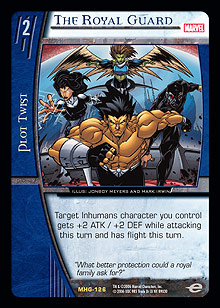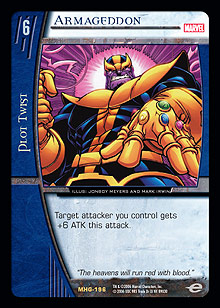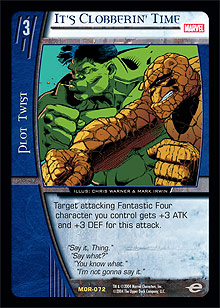
Hey everyone! Before I get started on my first article as a Vs. System R&D member, I thought a small introduction might be in order. Some of you who play in the NY area or have been to a Pro Circuit might already know me. You might also recognize me from some of the articles I’ve written in the past as a player for TCGPlayer.com. If not, I’ll just say that there isn’t much else to know except that I’ve been playing this game since the day it came out and jumped at the chance to work at UDE as a game designer/developer for Vs. System. I’ve been working here for about two months now and am still learning a lot about why certain things are how they are, so I thought I’d take a minute to give you guys a look through what feels like mirrored glass.
I liken it to mirrored glass because you never get a good idea of what goes on over here, but we pay very close attention to everything going on out there. When I started here, I was pretty surprised to see that every morning basically begins with everyone in the Vs. room sitting at their computers reading every online article we can find and thread after thread on the forums. I bet most of you didn’t know that you could make a difference, but it’s true. Any time you speak with one of us or write something online, it gets noticed. We take all of these things into account every day when making Vs. System; we’re trying to make it the best and most fun game we can.
That said, I saw an interesting post this morning on VsRealms.com and figured it was about time I answered some questions. I myself sometimes asked these same questions before I got here. Now, to get those answers, all I have to do is turn around in my seat and ask one of the guys here. I’d like to share that with you. Here’s the link to the thread on the VsRealms.com forums.
For those of you who don’t feel like clicking over and reading the thread yourselves, I’ll sum it up for you. It asks a pretty simple question that has a less than simple answer.
“Is The Royal Guard rare-worthy, and why?”

I could just tell you why we made The Royal Guard rare, but instead I’ll do one better and tell you what factors are involved in deciding the rarity of cards. There’s a reason to this rhyme or a rhyme to this reason, or something like that, so without further ado . . .
How Do We Decide What Cards to Make Rare?
There are a number of reasons, actually. Some cards are made rare for a single reason, and others are made rare for more than one. Some of the most common reasons include, but aren’t necessarily limited to:
Complexity
Some cards are just too confusing to make common or uncommon. We are making a game for players of all levels, and for a beginner, opening cards that they don’t understand can be pretty intimidating. This game is very complex as it is, and we certainly don’t need to increase the complexity of the game by making cards that are hard to understand more common. We also don’t want very complicated cards coming up frequently in Sealed Pack, which could result in people asking questions and calling judges over every few minutes. Think of any time you’ve had to read a card and then thought to yourself, “Man, I have no idea what this card does.” Then you have to go back and read it again more slowly. Picture that scene from Billy Madison where Billy’s learning a foreign language. The screen pans back to Adam Sandler, and he just says, “Slow down.” The guy repeats himself, and still you can’t understand a word of it, so Billy just says, “Ooooh,” and nods his head. That’s why cards are rare—you kind of have to speak the language to get it right away.
Some examples of cards like this from Heralds of Galactus are Exploiting the Flaw, Red Shift, and The Enemy Within.
Once you know what these cards do, it’s pretty easy to understand how they work, but when most people first read them, their reaction is “Huh?” After someone explains it in non-templated English, it’s pretty simple.
Too Many Words!
Some people might confuse this with complexity, but it’s not the same; some cards are very simple but require a ton of words to get the point across. A good example of this would be Absorba Shield. Basically, it says discard a card to get +2 DEF, and if your opponent doesn’t reveal a card that costs more than the one you pitched, you get another +2 DEF, for a total of +4 DEF. Not too tough to explain, but when it’s templated so that it works within the rules, it gets a little bit wordy.
Why do we care how many words are on the cards? Imagine you haven’t played in a while and you want to draft the new set. You open your pack and see two paragraphs on each card. It’ll take you about five minutes or so to read them all, so you might only read two or three cards, then give up and just take one. When the next pack has the same issue, you’ll just get annoyed. We try to make the majority of the cards (commons, since there are more of them) a little bit shorter so that you don’t have to read as much before you can get to the fun part and play some Vs. System.
Cool, Splashy Effects
Some cards are rare because they’re unique, powerful, and interesting. They’re the cards that you see for the first time and think, “Wow, cool!” For example, Karnak, The Shatterer and Armageddon. They’re just really cool cards that are very powerful in our game; +6 ATK is pretty big. A lot of the time, these cards will be bomb rares in Sealed Pack and are very good candidates for Constructed. Sometimes, things are just good old-fashioned fun. This is why Garth ◊ Tempest was rare in DC Origins and Savage Beatdown and Sabretooth, Feral Rage were rare in Marvel Origins—they’re just really good at what they do.

Narrow Cards
Sometimes we want to make cool cards that have little to no application in Sealed Pack. We don’t want people seeing three or four copies of a card that’s next to worthless for them, so we make them rare. Good examples of this are cards that refer to specific characters like Doomstadt, Castle Doom or I Must Obey. Other examples are cards that are really tough to use even if you can play them, such as Ego, the Living Planet; Strategic Retreat; or Attilan. Obviously, if you don’t have Dr. Doom, seeing a Doomstadt, Castle Doom in every pack will get old fast, so we made it rare. Another card I can think of is Lust for Power. It’s so narrow that you need a Dr. Doom in play to flip it, and then you probably can’t even use it effectively in Sealed Pack. We do like to make cards like this, though, because we want them around for people to build decks with in Constructed. We just can’t have twenty percent of the cards floating around the table being unplayable for Sealed Pack purposes.
Power Level
Sometimes cards are just plain good. While we do put powerful cards at all rarities, we like to make some of the most powerful cards rare. Mainly, it’s a Sealed Pack concern—we don’t want very powerful cards to be too easily available in every draft. Sealed Pack decks aren’t as well-equipped to handle these types of effects as Constructed decks tend to be, so it can make certain cards very difficult to play against. Some of the cards that are powerful effects in our game blunt your opponent’s initiative, so cards like Air-Walker, Gabriel Lan and I Must Obey (yes, I’ve used this one already) are made rare to prevent players from playing them all the time. Other powerful effects that aren’t necessarily initiative blunting, such as very good combat pumps, we generally make rare as well. Vs. is a difficult game, and planning your turn around what your opponent might have is tough enough. Having very big offensive or defensive tricks as commons would make games longer and more complicated than they already are.
Those are the most common reasons, but sometimes we do have other reasons that don’t exactly fit into any of those categories. So, back to the question at hand: Why is The Royal Guard rare?
Well, it’s up there as one of the most powerful combat plot twists we’ve made. I think the obvious thing to do is to compare it to It’s Clobberin’ Time!

Sure, +3 ATK / +3 DEF is bigger, but The Royal Guard has some other things going for it that, in my mind, more than make up for that 1 point of ATK and DEF. You’re trading in that point for flight and the more subtle turn duration (as opposed to attack duration). Any plot twist that lasts for the whole turn is a lot different from a plot twist that only lasts for a single attack. Sure, many times this won’t come up, but the ability to play things outside of combat is actually much more powerful than most people realize at first. Let’s not even mention when you’re able to attack more than once with that character, too! There’s a very specific Inhuman that’s my favorite target for The Royal Guard, but I’m sure I don’t have to tell you who that is for you to figure it out.
Also, the card is a little bit higher than the power level we want to see in Sealed Pack all the time. This card can be a pretty big blowout, so we don’t want people ending up with too many copies of it too easily.
Royal Guard, like many other rares, fits into more than one category. I Must Obey references Galactus and blunts initiatives. I think ninety-five percent of the cards we make rare fit into one or more of these categories. Just pick up any stack, and I’m sure you can determine into which category or categories each card fits.
I hope this cleared things up a little.
John Fiorillo